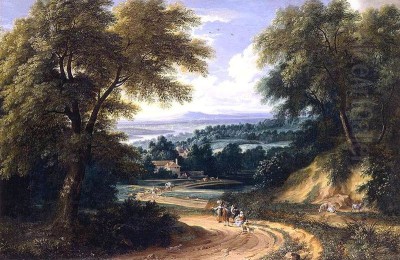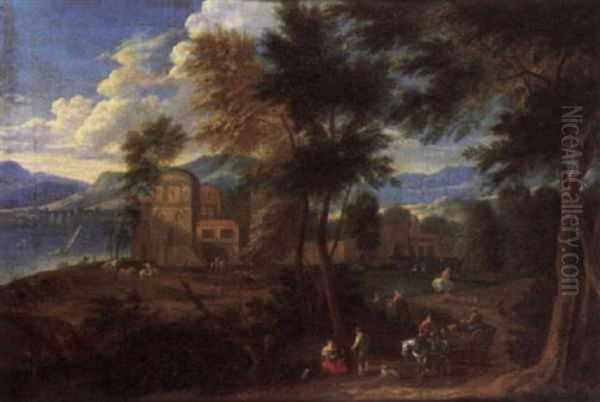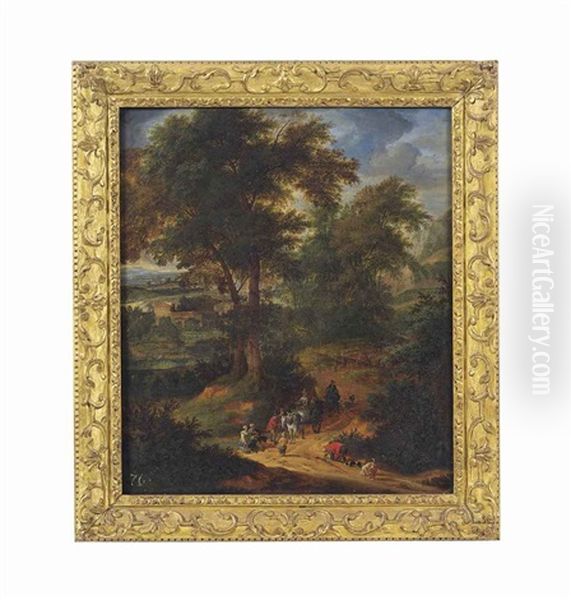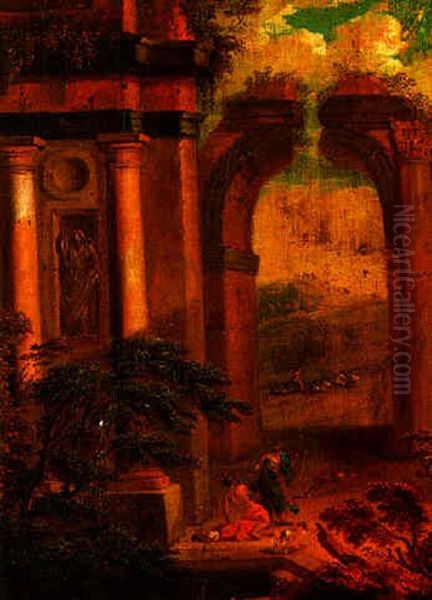
Adriaen Frans Boudewyns the Elder stands as a significant figure in the rich tapestry of Flemish Baroque art. Born in Brussels on October 3, 1644, and passing away in the same city on December 3, 1719, his life and career bridged the artistic worlds of the Southern Netherlands and the burgeoning artistic center of Paris under Louis XIV. Primarily celebrated as a landscape painter, Boudewyns developed a distinctive style characterized by meticulous detail, vibrant colour, and atmospheric depth. He was not only a painter but also a skilled etcher, contributing significantly to the landscape genre through both mediums. His journey took him from his native Brussels to the heart of the French art establishment and back again, leaving behind a legacy of finely crafted works and influencing fellow artists through collaboration and teaching.
Early Life and Training in Brussels
Adriaen Frans Boudewyns, often referred to as 'the Elder' to distinguish him from potentially related artists, entered the world in Brussels, a city with a long and distinguished artistic heritage. He was the son of Nicolas Boudewyns and Françoise Musson. His initial artistic education took place in his hometown under the guidance of Ignatius van der Stockt, a landscape painter and etcher active in Brussels during the mid-17th century. While perhaps not as widely known today as some other masters, van der Stockt provided Boudewyns with a solid foundation in the principles of landscape depiction prevalent in the Flemish tradition.
The artistic environment in Brussels during Boudewyns' formative years was vibrant, still echoing the influence of earlier masters like Jan Brueghel the Elder, whose detailed and jewel-like landscapes set a high standard. Contemporary landscape specialists such as Jacques d'Arthois were also active, known for their large-scale, often wooded scenes. Immersed in this milieu, Boudewyns honed his skills, demonstrating sufficient talent to be accepted as a master in the Brussels Guild of Saint Luke, the city's powerful artists' corporation, around 1665-1666. This official recognition marked the beginning of his independent career.
The Parisian Years: Collaboration and Recognition

Seeking broader opportunities, Boudewyns made a pivotal move to Paris around 1666. This relocation placed him at the epicenter of European art patronage, dominated by the court of Louis XIV. His talent was quickly recognized, leading to a significant professional association with Adam Frans van der Meulen. Van der Meulen, originally from Brussels himself, had become the preeminent painter of battles, hunts, and landscapes celebrating the French monarch's glory and was a key figure in the royal artistic projects.
In October 1666, Boudewyns signed a three-year contract to work as an assistant in van der Meulen's large and busy workshop. His primary role involved painting the landscape backgrounds and topographical details in van der Meulen's compositions. This often included work related to designs for the famous Gobelins tapestry manufactory, which produced luxurious wall hangings for the royal palaces under the overall direction of Charles Le Brun, the chief artistic arbiter of the era. Boudewyns' meticulous style was well-suited to rendering the detailed settings required for these prestigious commissions, which often depicted royal residences like the Château de Versailles or celebrated French military campaigns.
His connection to van der Meulen extended beyond the professional sphere. On January 12, 1670, Boudewyns married Adam Frans van der Meulen's daughter, Barbara. This union further solidified his position within the Parisian art world. Working alongside van der Meulen and other artists in the workshop exposed Boudewyns to the grand style favoured by the French court and provided invaluable experience in large-scale collaborative projects.
Collaboration with Pieter Bout
While in Paris, and likely continuing after his eventual return to Brussels, Boudewyns established another crucial artistic partnership, this time with the painter Pieter Bout. Bout, also a Brussels native who spent time in Paris, specialized in painting lively, small-scale figures. Their collaboration proved highly successful and prolific: Boudewyns would typically paint the expansive landscape settings, while Bout would populate these scenes with numerous animated figures, adding narrative interest and vibrancy.

This division of labour was common in the 17th century, allowing artists to focus on their respective strengths. The combination of Boudewyns' detailed landscapes and Bout's skillful staffage (the term for figures within a landscape) resulted in charming and engaging compositions. Their joint works often depict bustling village fairs, skaters on frozen rivers, busy market squares, Italianate harbour scenes, or tranquil pastoral gatherings. A typical example might be a work described as A Coastal Harbour and a Fortified Town, where Boudewyns would render the architecture, ships, and coastal scenery, and Bout would add the sailors, merchants, and townspeople going about their activities. Their styles complemented each other effectively, creating works that were highly sought after by collectors.
Artistic Style and Influences
Adriaen Frans Boudewyns the Elder developed a landscape style noted for its precision and clarity. He employed a fine brush technique, allowing for a high degree of detail in foliage, architecture, and distant vistas. His palette was generally bright and clear, often featuring cool blues and greens characteristic of Flemish landscape tradition, but sometimes warmed with the golden light associated with Italianate scenes. He demonstrated considerable skill in rendering atmospheric perspective, creating a convincing sense of depth and space within his compositions. His handling of light and shadow contributed to what some sources describe as a "theatrum mundi" or "world theatre" effect, presenting a detailed microcosm of the world within the frame.
His time in Paris and his work with van der Meulen undoubtedly refined his technique and perhaps broadened his thematic range. However, his core style remained rooted in Flemish traditions. Influences from earlier masters like Jan Brueghel the Elder are discernible in the meticulous rendering and encyclopedic detail found in some works. Furthermore, his landscapes often exhibit an Italianate sensibility – serene compositions featuring classical ruins, gentle hills, and luminous skies – suggesting an awareness of, if not direct influence from, artists who specialized in views of the Roman Campagna, such as the Flemish painter Jan Frans van Bloemen, known in Italy as 'Orizzonte'. Boudewyns successfully synthesized these various influences into a personal and recognizable style, distinct from the broader, more painterly approach of some Brussels contemporaries like Cornelis Huysmans. Beyond painting, Boudewyns was also an accomplished etcher, producing numerous prints that mirrored the themes and detailed execution of his painted landscapes.
Representative Works and Themes

Unlike some artists defined by a few iconic masterpieces, Boudewyns is known more for the consistent quality and character of his output across a range of landscape themes. His oeuvre primarily consists of pastoral scenes, river landscapes, views of villages and small towns, coastal scenes, and occasionally, hunting parties set within expansive natural settings. Works generically titled Pastoral Landscape with Carriage or Hunting Scene, as mentioned in preliminary research, point towards typical subject matter. These paintings often feature winding paths leading the viewer's eye into the distance, carefully rendered trees and foliage forming coulisses at the sides, detailed depictions of rural or fantastical architecture, and, especially in collaborations with Bout, a multitude of small figures engaged in various activities.
His landscapes project an air of tranquility and order, even when depicting busy scenes. There is a sense of careful composition and balanced arrangement of elements. Whether depicting the environs of Brussels, imaginary Italianate vistas, or scenes inspired by his time in France, Boudewyns consistently focused on creating believable, detailed worlds. The figures within, whether peasants working, travellers resting, or elegant couples strolling, serve to animate the scene and provide scale, reinforcing the overall impression of a carefully observed or constructed reality. His works provide a valuable visual record of the types of landscapes – both real and idealized – that appealed to collectors in the late 17th and early 18th centuries.
Return to Brussels and Later Career
Sources suggest that Boudewyns returned to his native Brussels sometime after his first wife, Barbara van der Meulen, passed away in 1677, although the exact date of his permanent return is debated, possibly occurring a bit later. Back in Brussels, he remarried (to Madeleine Curtiois, or Françoise Curtrois according to some records) and continued his artistic practice. He remained an active painter and etcher, producing landscapes that maintained the detailed quality and often Italianate flavour developed during his career.
He reintegrated into the Brussels art scene, bringing with him the prestige and experience gained from his years in Paris and his association with the French royal workshops. His presence would have contributed to the ongoing exchange of artistic ideas between the Low Countries and France. He continued to produce landscapes that found favour with local patrons and likely maintained connections with the art market beyond Brussels. His later works continue to show the refinement and technical skill that characterized his entire output.
Teaching and Legacy
Adriaen Frans Boudewyns the Elder played a role not only as a creator but also as a mentor and source of influence. His most documented pupil was Mathys Schoevaerdts, who was registered as his student in Brussels in 1682. Schoevaerdts went on to become a successful painter in his own right, specializing in landscapes and market scenes that clearly show the influence of Boudewyns' detailed style and compositional structures. Schoevaerdts became a master in the Brussels Guild in 1690.
Boudewyns also appears to have made an impression on the Dutch painter Gerard Hoet during the latter's visit to Brussels. According to accounts, Boudewyns persuaded Hoet to extend his stay in the city, suggesting Boudewyns held a position of respect among fellow artists. Furthermore, his artistic lineage continued within his own family. His son, Frans Boudewyns (or Boudewijns), also pursued a career as a painter. Additionally, one of his daughters married the painter Andreas Rysbrack, who was the son of the prominent Antwerp sculptor Pieter Rysbrack and brother to the painter Pieter Andreas Rysbrack and sculptor John Michael Rysbrack, further embedding the Boudewyns name within the artistic networks of the time.
His legacy lies in his contribution to the Flemish landscape tradition during the later Baroque period. He successfully blended meticulous native techniques with broader European trends, particularly the Italianate landscape and the requirements of French courtly art. His collaborations, especially with Pieter Bout, produced a distinctive body of work, and his role as a teacher ensured the continuation of his detailed style into the next generation.
Conclusion
Adriaen Frans Boudewyns the Elder navigated the complex artistic landscape of the late 17th and early 18th centuries with considerable skill and success. From his training in Brussels under Ignatius van der Stockt to his high-profile work in Paris assisting Adam Frans van der Meulen on royal commissions, and his fruitful collaboration with Pieter Bout, Boudewyns demonstrated both technical mastery and adaptability. His finely rendered landscapes, characterized by detail, clarity, and atmospheric sensitivity, secured his reputation in both Brussels and Paris. Influenced by Flemish predecessors like Jan Brueghel the Elder and contemporaries like Jan Frans van Bloemen, while also contributing to the grand projects overseen by Charles Le Brun, he embodied the interconnectedness of European art centers during the Baroque era. As a painter, etcher, collaborator, and teacher to artists like Mathys Schoevaerdts, Boudewyns left an indelible mark on the history of landscape painting. He passed away in Brussels in 1719, concluding a long and productive career dedicated to capturing the beauty and detail of the world, both real and imagined.